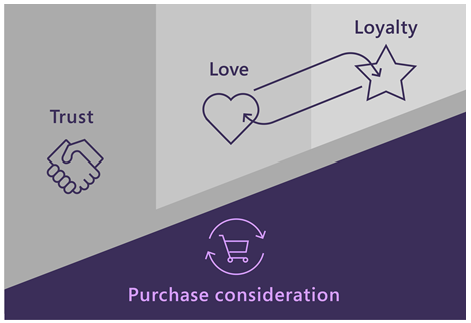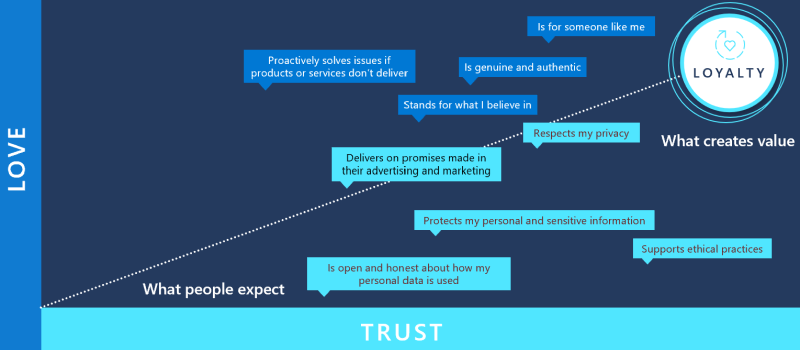Warren Buffett once said: “It takes 20 years to build a reputation, and 5 minutes to ruin it.”
Buffet’s insight applies to all relationships — between friends, family, and the relationship a brand has with its consumers. In fact, we talked about the importance of trust in
Marketing with Purpose makes a difference, where 85% of consumers will only consider brands they trust when making a purchase and 69% would never purchase from the brand again once they’ve lost trust in that brand.
Unsurprisingly, trust is pivotal between a brand and its consumers. Like any friendship, every interaction you have accrues to maintaining trust. For brands, that interaction includes both the acquisition and retention of consumers. It's not enough to settle for one interaction between your brand and consumers; you must maintain trust to keep them coming back to your brand. The top reasons that consumers lose trust in a brand are:
1.
Poor quality: “I did not believe in the company’s morals and ethics.”
If you cannot ensure that your product’s or service’s quality meets the consumer’s standards, you are unlikely to keep trust in your brand. This one is very difficult for marketers or advertisers to control but the other two causes are well within your influence.
2.
Not able to deliver on advertised messages or dishonest advertising: “They didn’t back up what they were trying to sell.”
Ensure your creative reflects the reality of your products and services. While it may be easy to embellish, it’s better to focus on what differentiates your brand and how it can solve a consumer’s challenge.
3.
Not aligned to consumer values or is unethical: “Product did not meet the vision the company created.”
Today’s consumers are smart, well-informed, and have choices. It’s important to lead with what your brand stands for and what your consumers care about, to create an alignment that drives message resonance.
Trust drives purchase consideration through brand love and loyalty

We saw from research that purchase consideration is made up of trust, love, and loyalty. Trust serves as that foundation which then leads to love and loyalty. These three elements are all highly correlated, where brand love builds on trust to increase consumers’ willingness to consider your brand, conduct repeat purchases and refer your brand to friends and family. By focusing on trust, you create stronger brand love, further increasing loyalty and connection with your brand.
Together, trust, love and loyalty create a laddering effect — trust builds love and love builds loyalty. This is the part of friendship we all treasure. It’s where customers become fans. In fact, 3 out of 4 consumers will pay more when they both trust and love a brand.
The trust curve – consumer expectations that build trust, love, and loyalty

So far, we’ve established the importance of trust, and how trust, love and loyalty work together to drive purchase consideration. What do consumers expect from your brand and how can you build trust, love and loyalty?
Trusted brands must first meet the fundamental needs of security, data protection and privacy. Marketers today recognise these needs as the cost of doing business, but many stop there. There is an opportunity to go beyond these foundational needs to create a relationship with consumers that can deliver greater business value.
The trust curve starts with the consumers’ foundational expectations of your brand and continues with expectations that are focused on driving love and loyalty.
Let’s start with the consumers’ foundational expectations of your brand. The closer these expectations get the loyalty line in the trust curve, the more they drive love and loyalty:
- Show openness and honesty. This can be transparency around the type of data collected, as well as how it will be used and protected.
- Support ethical practices. Share what your brand stands for and stay true to those values even when it’s inconvenient or more costly.
- Be responsible. Consumers have the expectation that brands will respect their privacy. Your brand can respond by adhering to opt-in policies or have a thoughtful approach to contact frequency.
- Deliver on the promises made in your marketing. This is about setting expectations and doing what you say.
As you build on the foundational expectations, your brand starts to move above the loyalty line in the trust curve. At this point, your actions against the consumer expectations drive more love and loyalty:
- Brands should stand for something. By having transparent values, consumers can get to know a brand, and see themselves reflected in it. People want brands that take a stand, not just play it safe.
- Be genuine and authentic. Whether it’s communicating your brand values or products and services, people want the truth.
- Provide strong customer support. A sale is only the beginning, by helping proactively solve issues, you are taking the opportunity to build a relationship.
- Ensuring your brand is built for someone like them. People want inclusion, not just to be included. This goes beyond multi-cultural marketing, to inclusive marketing — a manifestation of an authentic connection.
To maintain your brand’s reputation, focus on the key ingredient of trust. After all, you create transparency, have honest conversations, and take other actions to build trust in your personal friendships, why not apply this focus towards your brand to drive purchase consideration?
For insights, videos and more, visit us at
aka.ms/MarketingWithPurpose.